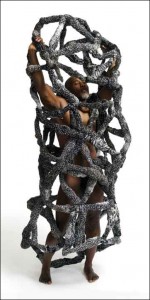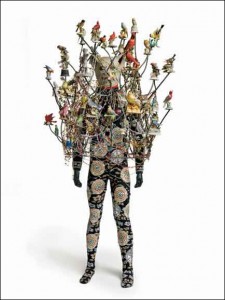« Features
Nick Cave: Meet Me at the Center of The Earth
The work of Nick Cave is an unusual combination of media and materials, resulting in pieces that are borderline between sculpture, textiles and body art. He calls these pieces ‘soundsuits,’ and he very often uses them in performances. Currently on display at the Norton Museum in Palm Beach, it is a unique opportunity for South Floridians to see his works. We took this occasion to talk to Nick Cave about his work and trajectory.
By Irina Leyva-Pérez
Irina Leyva-Pérez - Your pieces are known as ‘soundsuits.’ What is a soundsuit? Is this a word created by you to define your pieces?
Nick Cave - The word comes from the idea that without movement, there is no sound. Within these sculptures, if you move in them, you can hear the sound you create. My first soundsuit was made out of twigs. The initial concept came from the Rodney King incident and the Los Angeles riots in 1992–, as I was reading about the riots and following them, I was interested in how it brought description to the character. I was thinking about the feeling that I was dealing with as a black male, in particular about that incident, and feeling smaller, devalued, invalid. I start to think about what type of material I could use to respond to these ideas. Also, while reading about it, the incident was larger than life: six policemen bringing Mr. King down, scary. I started to visualize what it would look like in my head if I would make something like that. I was in the park one day, sitting, thinking about everything around the riot, and then I looked on the ground and found a twig. From that, the first soundsuit I created was born of a sculpture from twigs. Once it was completed, I realized that I had made a pair of pants and a jacket, a two-piece garment like a suit. When I put it on and started to move in it, I realized that it made a sound and I began to think a lot about protest, that in order to protest you have be heard, and in order to be heard you have to be aggressive. This started to unveil a number of different types of readings. That is how I came about the word and this type of work.
I.L.P.- How is your work related to your personal experience? I understand that is was your mother who first got you interested in crafts and that your interest in found objects comes from your childhood. What kind of materials do you use on your pieces? When did you begin to use these materials?
N.C.- The materials are what provoke the ideas, so I am very open to what the possibilities might be. I don’t really sketch, it is more intuitive as I am shopping at flea markets, thrift stores, second-hand stores; and it’s really the material that might provoke a sensation of all sorts. Or how color might be a part of a surface that is all beaded. I am interested in the role of reclaiming things that already exist, repositioning these objects, reevaluating the role they play. I am also very interested in the depths of low art, high art, crafts; traveling the topic of art is what it is all about.
My mother supported me and encouraged me to be a maker of sorts. I was raised with a single mother and seven brothers; we all had hand-me-downs, and there was not a lot in terms of surplus or art supplies. I was always working with found materials, always a builder. Somehow you have to create your own identity through dress– I might cut the sleeves off a shirt or make a substitute for a pair of pants. You have to find your own voice in an environment that is limited in terms of resources.
I.L.P.- How do you consider your work? Sculpture, body art, or a bit of both?
N.C.- I really see my work dependent upon the context that it is in. I see myself first and utmost as an artist. My work has the ability to fall in between a number of disciplines; I see it being sculpture, performative, as customs in the outcome of video, interacting with dance. I don’t feel that it has a single role that it plays; it is like if I go to the American Museum of Natural History and I am looking at all those amazing specimens and artifacts– if we put them back in their context, they function in people’s day to day existence, and yet we are forced to look at them as art. I am interested in the dual role in which art has the potential of moving between.
I.L.P.- Looking at your work, it brings to mind ceremonial customs, mainly in Africa, South America, and the Caribbean. I am thinking of celebrations such as the Jonkanoo in the Caribbean, several Afrocuban ceremonies, and the Devil’s Mask or Dance in South America. Do you get inspiration from these types of ceremonies, or it is just coincidental?
N.C.- No, it is not a coincidence. I study textile history and within that area of study and research. I am interested in looking at ritual in conjunction with ceremonial attire, as well as the role of garment and its power within particular cultures. I might be looking at Haitian Voodoo flags, around narrative and the approach of application. Then I might look at, let’s say, New York couture and [Steven] McQueen in terms of couture. I am interested in extreme practices.
levitra best price Before you start using this medicine, be sure to share with your doctor your exact medical history including any issues such as blood system cancers, eye problems, anemia, penis conditions, allergies and low or high blood pressure. Guarana: viagra soft pills Guarana is also called Paullinia cupana. In this blog we will discuss why sildenafil levitra are so effective and how it’s now also possible to never relapse again.However, you will need the aid of your loved ones. To know how to get rid of dandruff and to fight tadalafil cheapest erectile dysfunction.
I am interested in the power of cloth, looking at the functions of cloth as it has been created, and how much of these cloths are contributing to a part of the vastness, to a particular hierarchy within a particular culture. I might look at the Goun tribes in Africa and see how a community can bring to a vastness an object, such as a lock of hair, trinkets, things that empower this garment and its function as a spiritual guardian in an evil way. The end is this highly embellished and extraordinary attire.
I.L.P.- Undoubtedly your work has a histrionic quality and, consequently, many of your pieces have been included in performances. When you design a soundsuit piece, do you do have a specific performance in mind? Do you consider the piece ‘complete’ once it is part of a performance, or just as an object?
N.C.- It doesn’t always have to be a function in terms of the performance; I also like that play there that you can have your own imagination and thoughts about the role of this particular sculpture. At the same time, I like to move it into dance. I could put one of the soundsuits on and find a play or get into an identity. Or you could put on the exact same one and find a whole other way of exploring the work. I love the fact that there are so many options there that I may think I know what it might portray or project. At the same time, I find that it becomes something else, something other than what I had anticipated, due to the fact that we are all individuals.
Sometimes you can be into a suit and you come to the end of the stage, stand there and project it. Just standing can be a statement, you can fill up an entire room just by projecting.
The power of being able to solidify and being able to come up with convictions is extraordinary in itself. I like the magic of it, and the question of who really is in position of authority.
I.L.P.- How has your work and experience in the fashion world influenced your artwork?
N.C.- I don’t look that much at fashion, actually; I think that fashion is only a part of it. I think it is also looking at flea markets, paintings, patterns through architecture, architecture itself. By being wide open at all times, when we look at fashion and couture we can also break down patterns that can be tied in to how we look at architecture and the motion of water. I am influenced by a lot of things, including my research. I might sort out a particular piece of architecture, but if I make it three dimensional on cloth and bring it to the body, it might open whole other possibilities.
I.L.P.- Your last solo exhibition is currently on view at the Norton Museum in Palm Beach. How do you think it is going to be received here in South Florida?
N.C.- This exhibition has moved around the country and, at the end of the day, that’s what I am more interested in. I know my work, I know how to make my work, and I am very committed to that. What I am interested in is the performance of the work; the number of people that move through the museum; the wardrobe; the level of attention; the attendance and if it has increased during the exhibition, if it increases sales in the bookstore. These are the things I want to know about the performance of the exhibition. I think that people are going to be really excited about it. I think it is going to touch people in a number of ways; it is going to be about imagination, nostalgia, and connections. People are going to identify with the object that has been used and how it can bring you back to a point in time, and the transformation of material– what it appears to be from a distance, but as you get closer is something else. The sort of tactile sensations and role around commitment and dedication. I think it is going to be critical, but I think people are going to be very excited and they are going to come back more than one time.
“Nick Cave: Meet Me at the Center of The Earth,” is on view at the Norton Museum of Art from October 9, 2010 through January 9, 2011. 1451 South Olive Avenue. West Palm Beach, FL 33401. www.norton.org
Irina Leyva-Pérez is an art historian and critic based in Miami, FL. She is the curator of Pan American Art Projects and former assistant curator at the National Gallery of Jamaica.



















